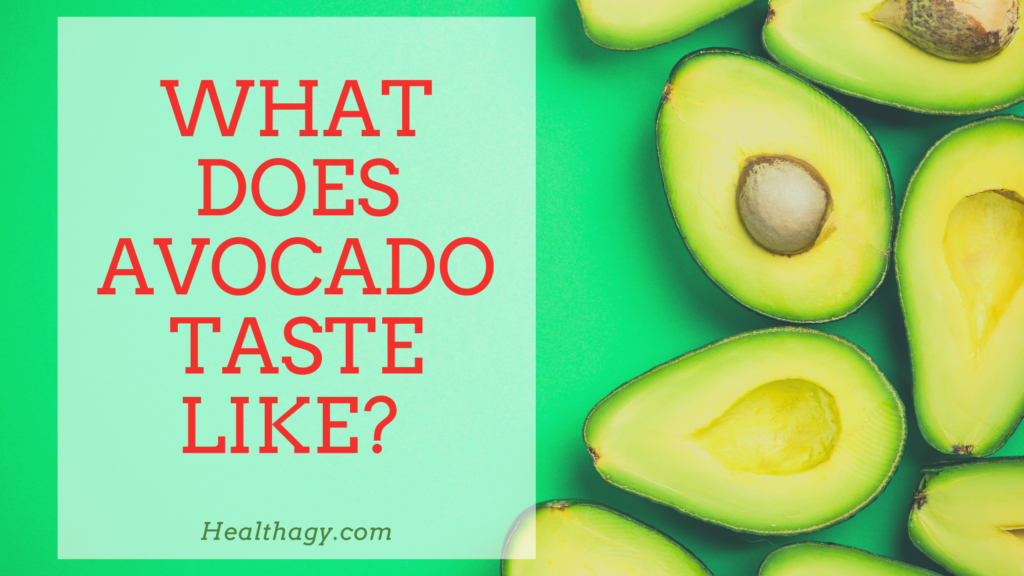
Yummy avocados! They seem to be everywhere, this delectable piece of fruit that is jam-packed with nutritional benefits. But if you are new to the world of avocados and looking to try one, you might be wondering what does avocado taste like?
What Does Avocado Taste Like?
The taste of avocado is a mild, slightly nutty, light, and creamy flavor. The flavor of avocado is a very light flavor with just a hint of sweetness and a tad of earthiness. It’s not a strong flavor at all. When eating an avocado, what’s most distinguishable is the smooth and creamy texture.
The flavor combined with its texture gives avocados such a unique taste and hard to replicate. Without avocados, we wouldn’t have the main ingredient in guacamole and so many other popular and delicious Mexican meals!
Avocados having such a light, mild flavor can also blend well into foods to make them creamier without adding much flavor. Smoothies are a great example, if you add avocado to a smoothie, you won’t notice much of a taste difference, but it will thicken the smoothie. Avocados can also help neutralize a spicy dish due to its mild flavoring.
What is an Avocado?
Avocado fruit is a popular superfruit found throughout Mexico and other areas of Central America and California. Avocados are technically a berry grown on a tree. They are shaped like a pear, with tough alligator-like green skin; some even refer to them as alligator pears.
The inside of an avocado is filled with creamy yellow flesh with a green tint to it, especially the area that is close to the skin and one large brown seed.
Types of Avocados
There are several types of avocados, with the three main types being Mexican, Guatemalan, and West Indian. Fuerte and Hass are the most commonly found varieties of avocados found worldwide, with the Hass variety being the most popular type of avocados. Hass avocados from California are the most commonly consumed avocados and are commonly found at the grocery store.
What are the Health Benefits of Avocado?
Avocados are packed full of nutrition, which is why they’ve earned the well-deserved title as a “superfruit.” A few of the bragging rights an avocado has are its nearly 20 vitamins and minerals and a mega-source of beneficial, heart-healthy fatty acids. A few of those nutrients include folate, magnesium, potassium, vitamins B2, B3, B5, B6, vitamin C, vitamin E, and vitamin K.
Perhaps avocado’s most notable health benefit is bragging rights as one of the fattiest plant foods. The healthy fat content in avocados is primarily oleic acid, a monounsaturated omega-9 fatty acid, which is also the main component found in olive oil and has been associated with reducing inflammation. Fats also help the body absorb other fat-soluble vitamins and antioxidants found in many plant foods.
How Do You Know When an Avocado is Ripe?
You can tell a ripe avocado by holding the avocado in the palm of your hand and applying gentle pressure. If it is firm, it is not yet ripe. If there is a bit of softness, it is ripe. If it is mushy, it is probably overripe.
One thing to be aware of if you are new to avocados is that the flavor and texture can vary depending on its ripeness, much like a banana. Overripe avocados will begin to have brown spots and become very mushy; they may have a more musky or fishy flavor. An unripe avocado is firm, stiff, sometimes even hard even to cut through, and therefore unenjoyable to eat.
How to Store Avocado?
Since we know ripeness affects the flavor of the avocado, let’s talk about the best way to store an avocado. If an avocado is firm, it is unripe, and you’ll want to leave it out at room temperature. If your avocados are ripe, yet you are not ready to eat them, you can place them in the refrigerator for up to 3-5 days. If you want to speed up the ripening process, you can put your avocado in a brown paper bag with an apple or banana.
How to Store Opened Avocados?
If you have opened the avocado, keeping air from it will prevent it from oxidizing and developing brown spots (like an apple). The best way is to squeeze lemon juice or lime juice on the creamy flesh and then get it as airtight as possible using plastic wrap or an airtight container to prevent it from browning.
When is an Avocado Bad?
When an avocado has gone bad, the skin begins to shrivel and dry out on the outside. The inside will have some brown spots, be extra mushy, and any yellow areas will be duller and may even have a brown hint to it.
Overly ripe avocados have oxidized as apples and bananas do. An overly ripe avocado is still safe to eat and is great for adding into bread or smoothies like you would an overly ripe banana.
Takeaway
If you haven’t already added avocados into your diet, I invite you to give it a try now that you know what avocado tastes like. While many people enjoy the mild, light, creamy and nutty flavor. The real benefit is those monounsaturated fats (healthy fats) that avocados are packed full of, which help lower blood sugar levels and lower cholesterol, which may help reduce the risk for heart diseases.
You can add a slice or two onto a sandwich, make guacamole to go along with your favorite tortilla chips, top off a salad, or even throw some into your favorite smoothie.
Karla Kueber is a Certified Evidence Based EFT Practioner and Health Coach, with a double Masters Degree in Education. She works with people to overcome emotional eating, curb cravings, and overcome resistance to eating new healthy foods. You can learn more about coaching with her here.